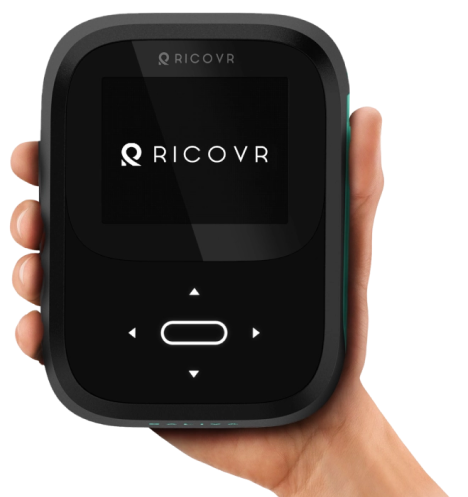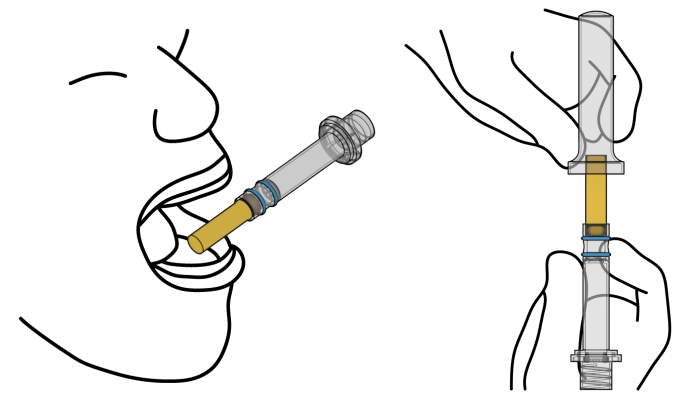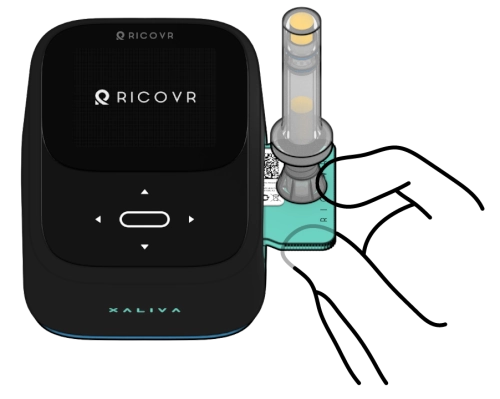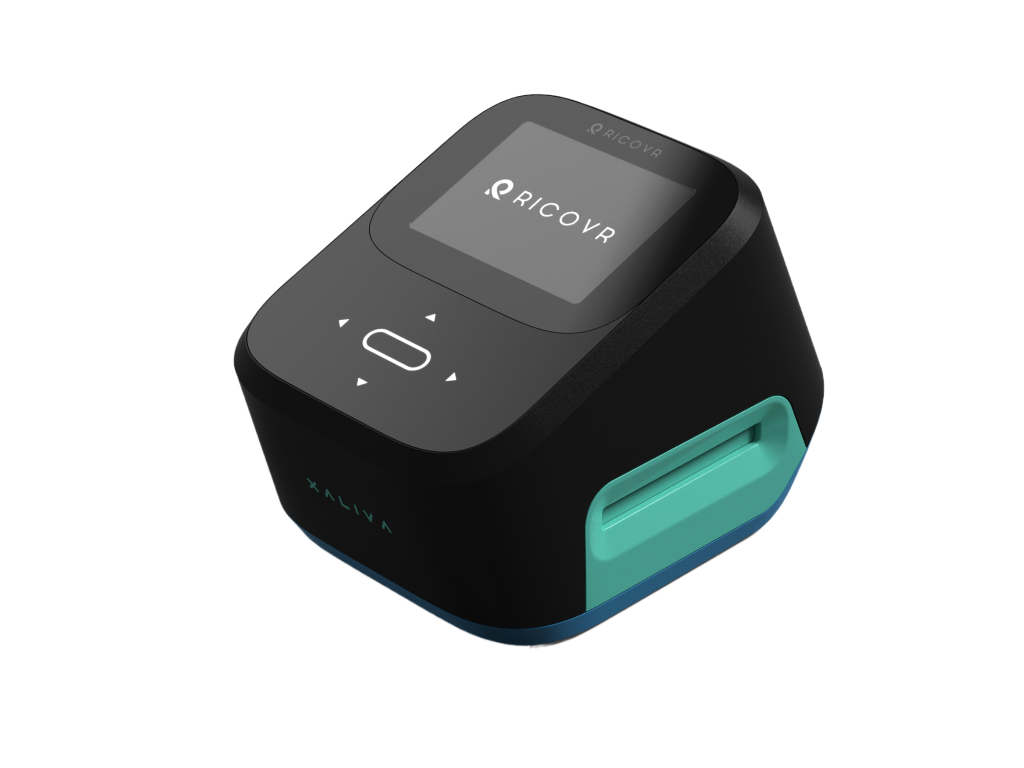Regarding recommending and/or purchasing XALIVA for my business, I’m Extremely Likely because we currently use rapid marijuana drug tests and are always looking for new options at reasonable prices. I would be Extremely Interested in learning more about XALIVA because this is an appealing option that would serve our purposes of curbing marijuana use at least on and during workdays.

Get Early Access to our THC Testing Device!
Fast, Affordable, and Accurate On-Site Testing


Key Benefits
Cost Effective Handheld Solution
Experience affordability and portability combined in our cutting-edge THC testing device. Convenient for on-site use without compromising on accuracy.

Saliva is the Future of Drug Testing
Embrace the future with saliva-based testing, ensuring non-invasive, quick, and reliable results.
Detect Recent Use
Ensure the utmost safety by accurately detecting recent THC use, enabling immediate and informed decisions.
Promote Safety in the Workplace

Enhance workplace safety with prompt and precise THC detection, ensuring a secure and productive environment for all
How It Works
Intuitive workflow uses 3 simple steps, providing
results within 10 minutes.
Step 1

Step 1
Collect saliva using the swab
and add to the tube
Step 2

Step 2
Connect cartridge with
XALIVA
Step 3

Step 3
Insert cartridge into the tube
and run test
Testimonials

Marie D.
Human Resources, Construction company
The industry that I work in is a very dangerous one, so being high on the job puts others at extreme risk of injury or even death. I personally suspect several people of using marijuana on the job and would like to see more on-the-job testing and feel that this product would be worth the cost and would help keep our employees safe.
Sam T
Safety Officer, Manufacturing company
FAQ
We have used urine-based testing for many years, why should we change our test method now?
There are two main issues with current urine-based marijuana drug tests – adulteration and the length of detection time in comparison to the window of impairment.
Adulteration refers to an individual cheating on a urine test. According to the Quest Drug Testing Index report, there was a 633% increase in cheating on urine tests last year. Another survey showed that 82% of drug testing experts said that they know people adulterate urine tests by either purchasing fake urine or using a clean sample from someone else to pass the test.
Marijuana urine tests detect metabolites in urine from a few days up to 30 days for marijuana. A comprehensive review of all impairment studies from Neuroscience & Behavioral Reviews suggests that cannabis impairment can last 3 to 10 hours, making urine-based testing ineffective and potentially unfair (19).
What is the window of impairment for marijuana?
A: The window of impairment is the length of time a person is negatively affected “high” from marijuana’s (THC) psychoactive properties. The latest science demonstrates significant impairment for up to 4.5 hours following smoking of cannabis. Other studies have shown the window of impairment can be as long as 12 hours depending on the task measured, the amount of THC consumed, the method of THC consumption, the frequency of consumption, as well as physiological differences between participants. (11-17)
Has my state changed its marijuana (thc) drug testing laws; can we still test?
A: Eight states have passed laws prohibiting adverse employment actions based on the use of cannabis off the job and away from the workplace. These laws place restrictions on the employer from taking adverse action on employees for using marijuana legally outside of work hours. Some states now require that employees exhibit signs of impairment before taking adverse action from a positive THC drug test.
Most of these new laws allow for testing in safety-sensitive positions and or based on the drug test method. For example, California has banned the use of tests that detect cannabis metabolites or past use. They will only allow tests that detect active THC molecules, or recent use with saliva-based tests. We compiled a breakdown of new marijuana (THC) employment laws that affect drug testing by state. To learn more click here.
*Disclaimer; this is only for informational purposes and not intended to be used as legal advice or opinion. Employers should always consult with their attorney on...
Why should I drug test for marijuana (thc) when it's now legal?
A: Workplace marijuana use is on the rise and causes impairment, which means skills such as reaction time, divided attention, cognitive performance, route planning, decision making, and risk taking are negatively affected. In one of the largest impairment studies of its kind, “Driving Performance and Cannabis Users’ Perception of Safety,” showed that both frequent and occasional marijuana users were impaired during a simulated driving task for up to 4.5 hours after smoking cannabis. (10-17)
Employees who test positive for marijuana have 55% more industrial accidents, as well as 85% more injuries and 75% more absenteeism. Marijuana users are more likely to cause a workplace accident and file a workers’ compensation claim. (7-9)
3.6x more likely to be involved in an accident.
5x more likely to file a workers’ compensation claim.
Average cost of a workers’ compensation claim is $41,353 .
How many employees are using marijuana?
A: In a 2018 study conducted by the CDC of the more than 10,000 workers surveyed, 14.6 percent answered yes to the question, “Did you use marijuana or hashish in the last 30 days?” The National Survey on Drug Use and Health reported marijuana drug use increased by 2.9 million users for a total of 52.2 million users within the U.S. in 2021. (2, 6)
Has marijuana legalization had any effect on the workplace? I don't believe it has changed in our workplace.
A: Legalization has led to a rise in workplace marijuana use; 1 in 3 Americans now live-in states where marijuana is legal for anyone at least 21 years old.
The percentage of employees in the general U.S. workforce testing positive for marijuana following an on-the-job accident increased to its highest level in 25 years in 2022, according to the Quest Diagnostics Drug Test Index. Employees self-reporting being “high” at work increased 60% from 2014 to 2019. 39% of marijuana users admit to going to work high at least once per week. 17% admitted to getting high while on the job with 63% of employees doing so at lunch or on a break. (1-5)
All
Pricing
Product
Support
TOP FAQ
All
We have used urine-based testing for many years, why should we change our test method now?
There are two main issues with current urine-based marijuana drug tests – adulteration and the length of detection time in comparison to the window of impairment.
Adulteration refers to an individual cheating on a urine test. According to the Quest Drug Testing Index report, there was a 633% increase in cheating on urine tests last year. Another survey showed that 82% of drug testing experts said that they know people adulterate urine tests by either purchasing fake urine or using a clean sample from someone else to pass the test.
Marijuana urine tests detect metabolites in urine from a few days up to 30 days for marijuana. A comprehensive review of all impairment studies from Neuroscience & Behavioral Reviews suggests that cannabis impairment can last 3 to 10 hours, making urine-based testing ineffective and potentially unfair (19).
What is the window of impairment for marijuana?
A: The window of impairment is the length of time a person is negatively affected “high” from marijuana’s (THC) psychoactive properties. The latest science demonstrates significant impairment for up to 4.5 hours following smoking of cannabis. Other studies have shown the window of impairment can be as long as 12 hours depending on the task measured, the amount of THC consumed, the method of THC consumption, the frequency of consumption, as well as physiological differences between participants. (11-17)
Has my state changed its marijuana (thc) drug testing laws; can we still test?
A: Eight states have passed laws prohibiting adverse employment actions based on the use of cannabis off the job and away from the workplace. These laws place restrictions on the employer from taking adverse action on employees for using marijuana legally outside of work hours. Some states now require that employees exhibit signs of impairment before taking adverse action from a positive THC drug test.
Most of these new laws allow for testing in safety-sensitive positions and or based on the drug test method. For example, California has banned the use of tests that detect cannabis metabolites or past use. They will only allow tests that detect active THC molecules, or recent use with saliva-based tests. We compiled a breakdown of new marijuana (THC) employment laws that affect drug testing by state. To learn more click here.
*Disclaimer; this is only for informational purposes and not intended to be used as legal advice or opinion. Employers should always consult with their attorney on...
Why should I drug test for marijuana (thc) when it's now legal?
A: Workplace marijuana use is on the rise and causes impairment, which means skills such as reaction time, divided attention, cognitive performance, route planning, decision making, and risk taking are negatively affected. In one of the largest impairment studies of its kind, “Driving Performance and Cannabis Users’ Perception of Safety,” showed that both frequent and occasional marijuana users were impaired during a simulated driving task for up to 4.5 hours after smoking cannabis. (10-17)
Employees who test positive for marijuana have 55% more industrial accidents, as well as 85% more injuries and 75% more absenteeism. Marijuana users are more likely to cause a workplace accident and file a workers’ compensation claim. (7-9)
3.6x more likely to be involved in an accident.
5x more likely to file a workers’ compensation claim.
Average cost of a workers’ compensation claim is $41,353 .
How many employees are using marijuana?
A: In a 2018 study conducted by the CDC of the more than 10,000 workers surveyed, 14.6 percent answered yes to the question, “Did you use marijuana or hashish in the last 30 days?” The National Survey on Drug Use and Health reported marijuana drug use increased by 2.9 million users for a total of 52.2 million users within the U.S. in 2021. (2, 6)
Has marijuana legalization had any effect on the workplace? I don't believe it has changed in our workplace.
A: Legalization has led to a rise in workplace marijuana use; 1 in 3 Americans now live-in states where marijuana is legal for anyone at least 21 years old.
The percentage of employees in the general U.S. workforce testing positive for marijuana following an on-the-job accident increased to its highest level in 25 years in 2022, according to the Quest Diagnostics Drug Test Index. Employees self-reporting being “high” at work increased 60% from 2014 to 2019. 39% of marijuana users admit to going to work high at least once per week. 17% admitted to getting high while on the job with 63% of employees doing so at lunch or on a break. (1-5)
Pricing
What is the window of impairment for marijuana?
A: The window of impairment is the length of time a person is negatively affected “high” from marijuana’s (THC) psychoactive properties. The latest science demonstrates significant impairment for up to 4.5 hours following smoking of cannabis. Other studies have shown the window of impairment can be as long as 12 hours depending on the task measured, the amount of THC consumed, the method of THC consumption, the frequency of consumption, as well as physiological differences between participants. (11-17)
Has my state changed its marijuana (thc) drug testing laws; can we still test?
A: Eight states have passed laws prohibiting adverse employment actions based on the use of cannabis off the job and away from the workplace. These laws place restrictions on the employer from taking adverse action on employees for using marijuana legally outside of work hours. Some states now require that employees exhibit signs of impairment before taking adverse action from a positive THC drug test.
Most of these new laws allow for testing in safety-sensitive positions and or based on the drug test method. For example, California has banned the use of tests that detect cannabis metabolites or past use. They will only allow tests that detect active THC molecules, or recent use with saliva-based tests. We compiled a breakdown of new marijuana (THC) employment laws that affect drug testing by state. To learn more click here.
*Disclaimer; this is only for informational purposes and not intended to be used as legal advice or opinion. Employers should always consult with their attorney on...
Product
Has marijuana legalization had any effect on the workplace? I don't believe it has changed in our workplace.
A: Legalization has led to a rise in workplace marijuana use; 1 in 3 Americans now live-in states where marijuana is legal for anyone at least 21 years old.
The percentage of employees in the general U.S. workforce testing positive for marijuana following an on-the-job accident increased to its highest level in 25 years in 2022, according to the Quest Diagnostics Drug Test Index. Employees self-reporting being “high” at work increased 60% from 2014 to 2019. 39% of marijuana users admit to going to work high at least once per week. 17% admitted to getting high while on the job with 63% of employees doing so at lunch or on a break. (1-5)
Support
We have used urine-based testing for many years, why should we change our test method now?
There are two main issues with current urine-based marijuana drug tests – adulteration and the length of detection time in comparison to the window of impairment.
Adulteration refers to an individual cheating on a urine test. According to the Quest Drug Testing Index report, there was a 633% increase in cheating on urine tests last year. Another survey showed that 82% of drug testing experts said that they know people adulterate urine tests by either purchasing fake urine or using a clean sample from someone else to pass the test.
Marijuana urine tests detect metabolites in urine from a few days up to 30 days for marijuana. A comprehensive review of all impairment studies from Neuroscience & Behavioral Reviews suggests that cannabis impairment can last 3 to 10 hours, making urine-based testing ineffective and potentially unfair (19).
How many employees are using marijuana?
A: In a 2018 study conducted by the CDC of the more than 10,000 workers surveyed, 14.6 percent answered yes to the question, “Did you use marijuana or hashish in the last 30 days?” The National Survey on Drug Use and Health reported marijuana drug use increased by 2.9 million users for a total of 52.2 million users within the U.S. in 2021. (2, 6)
TOP FAQ
No Accordion Items Found

Secure Your Spot for Early Access Today!
Don’t miss out on revolutionizing your THC
testing process with Ricovr’s innovative solution.



